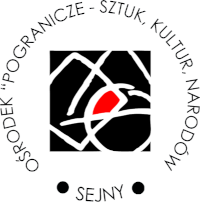Just a bit later the Borderland Foundation and Centre were “born” and our first office was in the old yeshiva opposite the synagogue. It is also here that the Art Studio, our first visual arts workroom was placed. It is here that the first results of our artistic activities happened: exhibitions, open-air meetings, scenography for our theatre productions, such as the Dybbuk, Wijuny and the Sejny Chronicles. Here I met young people so that we would learn together the non-verbal language of art and with the help of this language talk about our common world of Sejny, versatile with its cultural, religious and ethnic richness. I think that it is this versatility that was the reason for my returns to this world and it also became the most important issue of the “struggles” in our studio.
The Art Studio has had its new location in the building next to the Krasnogruda manor, but despite that, the focus of our interests and issues that inspire us and we want to talk about has remained the same. It is the story of the advantages of diversity.
The artistic techniques that we learn, acquire and make use of in each of our activities are varied. The results of what we have done often meet the broader framework of the mission of the whole Centre and Foundation. Such example was our presence during the open-air event of the Invisible Bridge in the amphitheatre of Krasnogruda for which we had been working on the elements of scenography or – just t bring up the most recent time –our work devoted to the three poets strongly connected to our Sejny region and its brief description will be a good example of how and what we do exactly.
Throughout 2019 we used to meet in the art studio in Krasnogruda -- Wiesław Szumiński and ten young people from the middle school in Pociunki and high school in Sejny – in order to collect the information about Atanas Baranauskas, Moris Rozenfeld and Czesław Miłosz, to talk about them and discuss their work in a language with a difference, the language that we learn during our sessions, the language of image, drawing, engravings, the language typical for artbooks. Our purpose was to work on the book devoted to three poets connected to the Sejny region either because of a particular birthplace – like Moris Rosenfeld, or because of the function they performed in the local Church – like bishop Branauskas or because our studio is placed in the manor of Miłosz’s family. We created a series of engravings and drawings that illustrate their poems. In the summer we paid a visit to their birth and life places – to Onykszty, Szetejnie in Lithuania and Boksze Stare in Poland and to the basilica in Sejny. We saw their houses, the places they lived and wrote in. In the autumn, enriched by this experience we designed and printed our BOOK.
But before printing the book – in the summer, in August – we prepared on the meadow of Krasnogruda next to the manor and the studio, the open- air exhibition for which we had used field stones on which we wrote some of the poems selected by us for the book that we had been working on.
Time goes by, and the Art Studio and the Artbook Studio continue working with more and more realizations, workshops, installations and exhibitions behind…
2022, the year of the war in Ukraine, has brought numerous meetings with the artists who have arrived at our studio from many different towns and cities from Ukraine. Here, they have found shelter and space where they can work, paint, prepare engravings inspired by the poetry written by the Ukrainian writers who have also fond home in exile here. It is also here that we are working on the series The Collection of Ukrainian Poetry. Facing the War. The first ten books are ready. There shall be more…
Wiesław Szumiński


